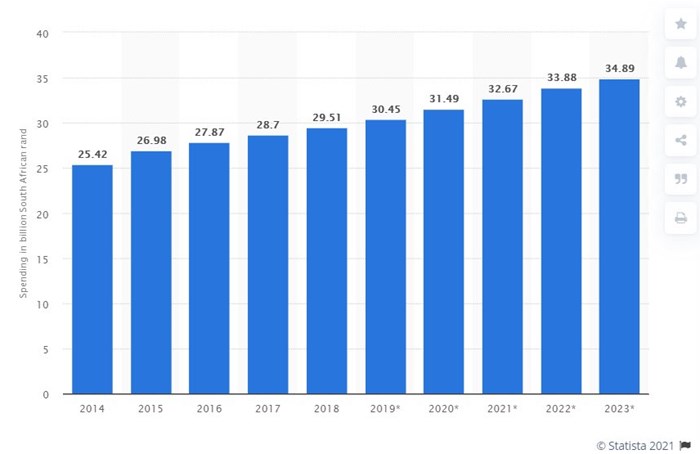If it is true that 50% of small businesses fail within the first five years, and the three common causes are known: lack of cash flow, budget overspends, and failure to work from an effective game plan, then continuing to do what isn't working rather than finding something more sustainable is madness.

Image supplied
While we cannot claim to fix all of these challenges, what we can do is give SMEs and entrepreneurs some idea on how to maximise their advertising budgets effectively. This should help keep costs down while increasing customer reach which should hopefully increase cash flow.
The current landscape
Competition in the advertising space is fierce. The cost of social media advertising - a favourite digital channel for most organisations - is climbing at a rapid rate around the globe. Recent stats indicate that worldwide social media spend grew from $16bn to $31bn in just two short years.
Closer to home, advertising budgets in South Africa are expected to grow from R29.5bn in 2018 to R34.9bn in 2023.
We know that small businesses don’t have the same budget as their larger counterparts, but they can still be successful. That being said, it is more difficult to achieve success when you spend less money on your marketing and advertising campaigns. However, there are some ways for you to maximise your return from a limited budget by utilising different channels of communication like outdoor advertising, SEO, or digital ads.
The key is to find the right balance of driving traffic, converting visitors into customers, and building a loyal audience. If you're struggling with how best to spend your marketing Rands or if you need help creating an effective strategy that'll grow sales, then read on!
Why do SMEs and entrepreneurs need a marketing budget?
As with most budgets - be it personal finance or for your business operations - your marketing and advertising also needs a budget. The reasons are straightforward enough:
- Helps you keep track of spending and prevents overspending.
- Helps you allocate spending per channel. Allocating a fixed amount per channel can also help you measure which channel brings in the better ROI.
- It helps you set realistic benchmarks and achievable goals that move your business forward.
- It helps you plan long-term for a more consistent marketing strategy.
- It helps shift your view from seeing advertising as an expense to regarding it as an investment in your business’s growth.
How to plan and maximise a marketing budget
Creating an effective marketing budget is the first step in maximising it. Here’s how.
1. Identify the right audience
“Those who fail to plan, plan to fail” as the age-old adage goes. As trite as it sounds, it is still very true. The first place to start when it comes to marketing and advertising is with a comprehensive marketing strategy.
You can sit with your team and brainstorm this together, or you can use a marketing strategist to facilitate.
Here you will identify:
- Who is your ideal customer? The best place to start is to think of your favourite existing customer, and try to find more of them!
- Their demographics - Age, interests, gender, profession
- Their location - Hyper-localised marketing channels are tremendously effective for location-based target audiences, particularly if you are a brick-and-mortar enterprise
- What are their points of pain? What problems and frustrations are they dealing with
- How does your product or service solve this? Speak to their point of pain
- Where are they? Identify which online channels they use, and how you can reach them off-line for an integrated marketing strategy
2. Reach the right audience
Hubspot has a proven proprietary method that will help you target your audience effectively.
Get the most out of your marketing budget by focusing all your efforts on advertising that will reach your ideal customers at the various stages of their buying journey.
There are four stages:
- Attract — This is the brand awareness / visibility portion of your strategy to attract new customers. This could be through social media posts, through outdoor advertising, through brochures, anything to increase visibility.
- Convert — Create a message and offering that will convert those who are interacting with your brand into leads. You can then nurture them in a more segmented and relevant way.
- Close — Personalised content sent to prospective leads is the most effective way to closing that sale.
- Delight — Now that they are your customer, strive to delight customers with products and services. This will not only keep them coming back for more, but will help bring in new customers.
3. Define your costs
The only way to control costs is to identify where your money is going in the first place. Start by identifying overall expenses throughout your company:
- Operational costs (creating products, shipping them)
- Salary expenses
- Overhead costs (electricity, water), and more
Now that you understand how much it costs to provide a service or sell a product, you will know if the cost of acquisition (advertising) is worth your while. This information will help guide you to strategies that allow you to get the best ROI for your business and advertising.
4. Set your advertising goals
The only way to know if your advertising is successful is if you set specific, achievable, realistic, measurable goals. These should support the business’s overarching objectives.
It is worth noting that not all marketing activity must or will result in a lead. Consider point #2 above. Each advert or post or channel needs its own goal, eg:
- Newsletters read
- Clicks to the website
- Contact forms submitted / leads generated
- Growth in subscribers
- Increased brand awareness
- Brochures delivered, and more
If you understand that the goal is to be present at every stage of the buyer’s journey, then setting realistic goals will ensure your marketing budget is utilised to the max.
5. Deploy your strategies - Multi-channel is best
There are many marketing channels and strategies you can deploy.
Typically a multi-channel approach is best, as this will ensure your message and offering reaches your target audience in most of their favourite mediums. Consider creating a marketing bouquet of these channels:
- Search engine optimisation (SEO)
SEO is an effective way of bringing traffic to your website for key search terms that your target audience uses to find products or services that you offer. While your website developer may be amazing at creating websites, they may not have the requisite SEO skills, so be sure to ask before you assume.
Consider optimising for local SEO through targeting geographical keywords. This is great when you want to rank based on a geographical search, like “online furniture store in Cape Town” or “the best pizza in Alberton”. Also, be sure to claim your Google My Business local listing.
Worth noting that this is not a quick-win, as effective SEO can take many months. However, it will support your long-term marketing strategy and serve you well down the line, so start sooner than later. Content marketing (blogs, videos, infographics) is a great way to grow your SEO over time.
- PPC advertising
Google Ads are pay per click (PPC) advertisements that appear at the top of Google’s search results pages and on other web pages. You only pay when someone clicks on your ad, and the cost is determined by bids set by others competing for the same keywords.
However, while Google Ads is effective for brand awareness, engagement, and conversions, consider how the average person is bombarded with over 1,700 banner ads per month. Statistics show that they typically only see half of them. Thus, it would be unwise if you rely solely on PPC. Consider outdoor or offline strategies and social media marketing to complement your Google Ads.
- Social media marketing
Social media marketing allows you to connect organically and directly with your audience to build relationships with leads. You can also do social media advertising for sponsored content.
- E-mail marketing
E-mail marketing is a high-converting channel that allows you to send lead-nurturing content directly to your segmented database. This can be in the form of promotional emails, exclusive deals, abandoned cart reminders, news and insights, and more.
- Outdoor advertising
There are many options when it comes to outdoor advertising. South Africans are outdoorsy and spend a lot of time commuting to and from work, this is a worthwhile channel to invest in.
Billboards - While these may blow most SMEs and startups’ marketing budget out the water, they are still effective at traffic lights for brand awareness.
Street poles - More common in Gauteng than in the Cape Town, these can be effective in bringing a story across if executed well. However, these need to be approved by the authorities before they are allowed to be installed.
Branded delivery bikes - This is the latest, hottest, most affordable outdoor marketing channel to hit the streets in South Africa (pardon the pun), and for good reason. Branded delivery bikes enjoy greater exposure and reach than billboards, and are 100% legal unlike street poles.
MotionAds is the creator of this channel and is driven by results. This channel is everything, it's 1) affordable 2) effective 3) convenient 4) proven 5) hyper-localised and 6) transparent and trackable.
This channel not only brings your billboard directly to your customer’s home, it spreads awareness to a hyper-localised area. Plus it associates your brand with the comfort items they have ordered (eg, takeaways), and reaches your target LSM directly. Affordable, a little guerilla-style in its tactics but safe as houses, it is ideal for SMEs and entrepreneurs.
Final thoughts
Skilled advertisers often use a technique called “affective condition”. This is where a product is displayed next to other things that evoke a positive feeling in consumers. For example, washing powders associating themselves with babies, sunshine, hugs, and flowers, even though the detergent itself has nothing to do with those things. Repeatedly displaying your brand alongside feel-good experiences, such as the comfort and convenience of home food delivery, gives your brand some of that feel-good equity.
It can be difficult for small businesses to get the word out about their products and services, especially if you are trying to penetrate a new market or launch a new product. If you’ve found yourself in this position, hopefully these tips will help you maximise your advertising and broaden your reach while also staying within the limits of your budget.



































